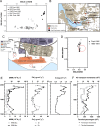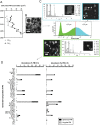The evolution of atmospheric particulate matter in an urban landscape since the Industrial Revolution
- PMID: 37268751
- PMCID: PMC10238512
- DOI: 10.1038/s41598-023-35679-3
The evolution of atmospheric particulate matter in an urban landscape since the Industrial Revolution
Abstract
Atmospheric particulate matter (PM) causes 3.7 million annual deaths worldwide and potentially damages every organ in the body. The cancer-causing potential of fine particulates (PM2.5) highlights the inextricable link between air quality and human health. With over half of the world's population living in cities, PM2.5 emissions are a major concern, however, our understanding of exposure to urban PM is restricted to relatively recent (post-1990) air quality monitoring programmes. To investigate how the composition and toxicity of PM has varied within an urban region, over timescales encompassing changing patterns of industrialisation and urbanisation, we reconstructed air pollution records spanning 200 years from the sediments of urban ponds in Merseyside (NW England), a heartland of urbanisation since the Industrial Revolution. These archives of urban environmental change across the region demonstrate a key shift in PM emissions from coarse carbonaceous 'soot' that peaked during the mid-twentieth century, to finer combustion-derived PM2.5 post-1980, mirroring changes in urban infrastructure. The evolution of urban pollution to a recent enhanced PM2.5 signal has important implications for understanding lifetime pollution exposures for urban populations over generational timescales.
© 2023. The Author(s).
Conflict of interest statement
The authors declare no competing interests.
Figures






References
-
- World Health Organisation. Air Pollution the Invisible Killer. https://www.who.int/health-topics/air-pollution (Accessed 20 May 2019).
Grants and funding
LinkOut - more resources
Full Text Sources

